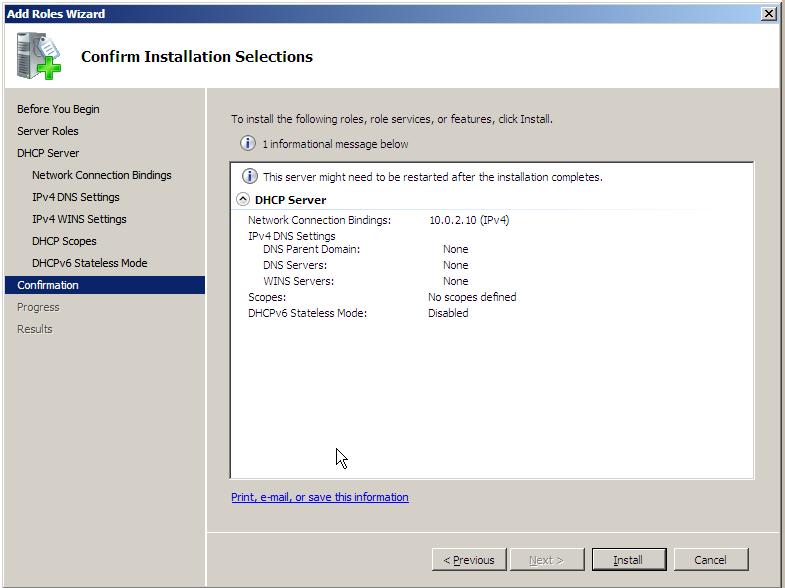Configuring Windows Server 2008 DHCP Servers
Installing the DHCP Server Role
The first step in setting up a DHCP server on a Windows Server 2008 system is to install the DHCP Server feature on any servers with are required to provide the service. Before performing even this initial task, it is highly recommended that any systems designated to act as DHCP servers be assigned a static IP address. If the server is currently obtaining a dynamic IP address from another DHCP server, begin the installation process by assigning the system a static IP address. This can be achieved by launching the Server Manager and clicking View Network Connections. Right click on the network adapter on which the DHCP service is to be run and select Properties where either, or both the IPv4 or IPv6 address may be changed from automatically obtaining an IP address to specifying a static address. Once configured, exit from the properties dialog and network connections window leaving the Server Manager running.
Installation of the DHCP Server Role is performed by selecting Roles from the tree in the left hand pane of the Server Manager tool. On the Roles page, click on the Add Role link to launch the Add Roles Wizard. Dismiss the welcome screen if it is displayed, and in the Select Server Roles screen select the check box next to DHCP Server before clicking the Next button, read the information provided and click Next again to proceed to the Network Connection Binding screen. It is wihitn this screen that the DHCP server is associated with specific network adapters installed in the system. Select the network adapters for which the DHCP service will be provided and click Next.
DHCP can be used not just to provide clients with an IP address, but also additional information such as the name of the parent domain (for example techotopia.com) and the IP addresses of both preferred and alternate DNS servers. If the DHCP is required to provide these details for IPv4 clients, enter them into the Specify IPv4 DNS Server Settings page and click Next.
On the IPv4 WIN Server Settings page, enter addresses of the Preferred and Alternate WINS servers if required. Otherwise, leave the WINS is not required for applications on this network option selected and proceed to the next configuration page.
The next page allows initial DHCP scopes to be configured. A DHCP scope defines one or more ranges of IP addresses from which an IP address may assigned to a client and the duration of of the IP address lease (6 days for wired clients and 8 hours for wireless clients). This may either be configured now, or at a later point in the configuration process. The topic of defining DHCP scopes is covered in the Defining DHCP Scopes section of this chapter.
With the initial DHCP IPv4 configuration steps completed, the wizard subsequently moves on the the IPv6 settings. This is where a little background information is useful. Windows Server 2008 supports two modes of IPv6 DHCP operation, known as stateless and stateful. In stateful mode, clients obtain both an IP address and other information (such as DNS addresses) though the DHCPv6 server. In stateless mode, the clients receive only the non-IP address information from the DHCPv6 server. In this case, the IP address must be provided using some other mechanism, either by configuring of static IP addresses or through the implementation of IPv6 auto-configuration.
On the Configure DHCPv6 Stateless Mode screen, select either stateful or stateless mode in accordance with your specific enterprise requirements. If stateless mode is selected the next screen will prompt for the IPv6 DNS information to be provided to clients. Enter the information and click on Next. If the DHCP is part of an Active Directory domain, the Authorize DHCP Server page will appear. Enter the credentials (either your own as shown, or alternate credentials via the Alternate Credentials button) necessary to authorize the new DHCP server. Alternatively, the authorization may be performed later by skipping this step by clicking on Next.
Upon completion of the DHCP server configuration the summary screen will displayed similar to the one illustrated below:
Assuming that the summarized configuration is correct, click on Install to complete the installation process. The wizard will display the progress of the DHCP Server Role installation before displaying a results screen confirming the successful installation. Once installation is complete, the DHCP Server may be managed locally or remotely using the DHCP console (Start -> All Programs -> Administrative Tools -> DHCP).
Authorizing DHCP Servers in Active Directory
If a DHCP server is to operate within an Active Directory domain (and is not running on a domain controller) it must first be authorized. This can be achieved either as part of the DHCP Server role installation, or subsequently using either DHCP console or at the command prompt using the netsh tool.
If the DHCP server was not authorized during installation, invoke the DHCP console (Start -> All Programs -> Administrative Tools -> DHCP), right click on the DHCP to be authorized and select Authorize. To achieve the same result from the command prompt, enter the following command:
netsh dhcp server serverID initiate auth
In the above command syntax, serverID is replaced by the IP address or full UNC name of system on which the DHCP server is installed.



